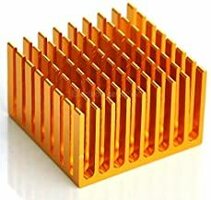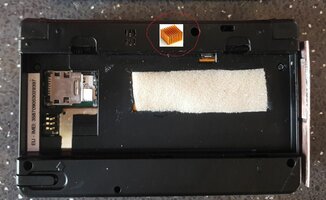Orderes an extra Case for Modifications

Yeah, I hope evildragon orders a few spare cases as chopping them up is a rush!
About putting a bigger heat sink on the cpu to usb heat path: I think we need to work out the thermal resistances for the original cpu board heat spreader and the thermal resistance for the heat sink.....
The cpu board heat spreader is 0.3mm thick copper and 15mm wide, so has a cross-sectional area of A=0.3 x 15 = 4.5mm^2 = 4.5e-6m^2.
It transfers heat a distance of about 20mm = 0.02m.
The thermal conductivity of copper is k=385 W/m/K.
The thermal resistance is given by R = distance / (area x conductivity) = 0.02 / (4.5e-6 * 385) = 12 Celcius per Watt.
The existing heat sink looks to be about 70 C / W judging by the RS catalogue, and if its well attached the the USB port, maybe 50 C / W.
@ingoreis, because the heat spreader is a lower resistance than the heat sink on the usb port, I agree that the heat sink is the bottleneck and we could benefit with a 10C / W heatsink over the USB ports. More air flow would help too.
I've observed that when the CPU is at 90C, the existing heatsink is still just comfortable to hold a finger against. That means the heatsink is ~45C. So, the temperature drop is deltaT= 90-45=45C. With a thermal resistance of 62 C / W, it means we're getting 45 / 62 = 0.7W out of the existing heat sink. The rest of the CPU heat is going into the keyboard (good) and the battery (not good).
But, how much power does the OMAP5 use at full load?




